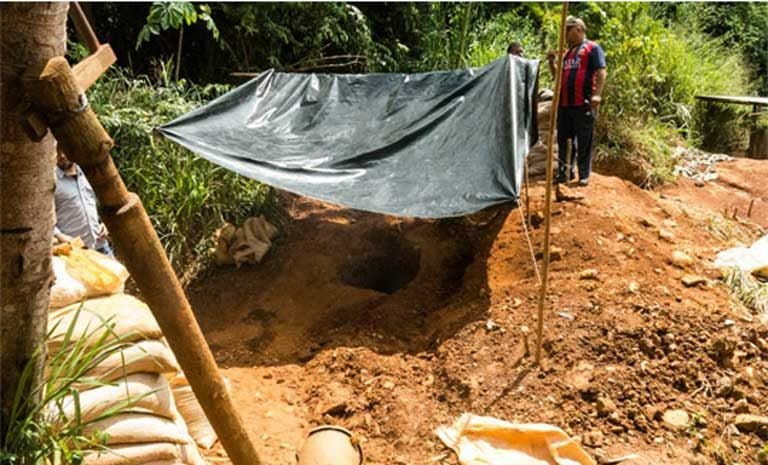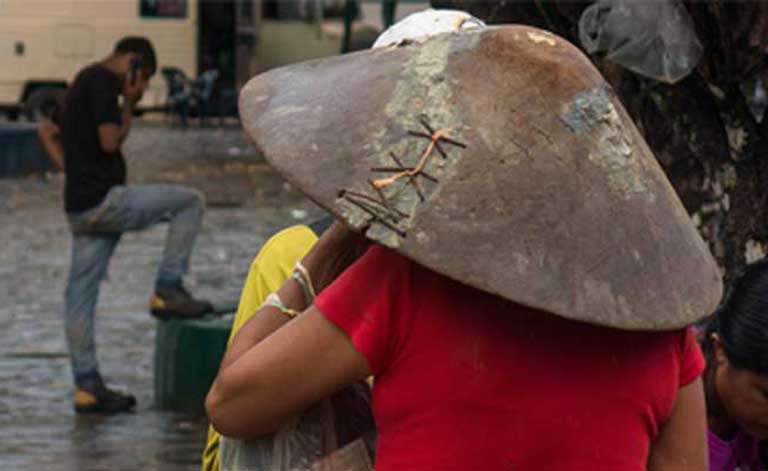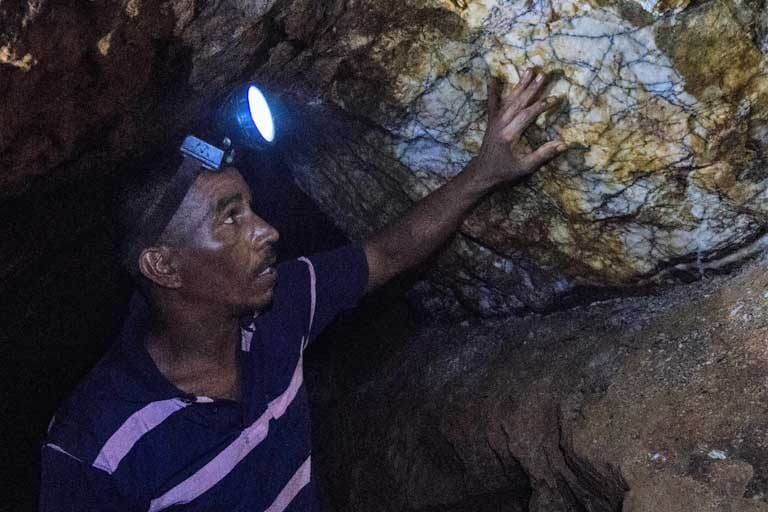- Venezuela is fast becoming a failed state, with 11.4 percent of its children malnourished, 10.5 percent of its workforce unemployed, and an annual inflation rate of roughly 2,700 percent for 2017.
- Serious food, fuel and medicine shortages have in recent months resulted in mobs raiding stores and shops, fishing boats, even the stoning of a cow to death where it stood in a field, in order for people to be able to provide for their families.
- Meanwhile, Pres. Maduro has sought to save his nation from economic ruin by selling off its natural resources, opening the Arco Minero in Bolívar state to mining – 112,000 square kilometers, more than 12 percent of the country. He has also announced the creation of the Petro cryptocurrency, backed by the nation’s oil and possibly minerals.
- Mongabay correspondent Bram Ebus, in partnership with InfoAmazonia, recently traveled to the remote Arco Minero and reported firsthand on the chaotic political and social situation, where indigenous communities and the environment are put at risk by economic hardship, a corrupt military, armed gangs and guerrilla bands.

This story is the fourth in a series of Mongabay articles about Venezuela’s Arco Minero, produced in partnership with InfoAmazonia which has launched an in-depth multimedia platform called Digging into the Mining Arc, exclusively highlighting Venezuela’s mining boom. The first three Mongabay stories by Bram Ebus can be found here, here and here.
Venezuela, its people and environment, are in terrible trouble. In 2017, its “economic, humanitarian, and political crises continued to deepen. The country is now on the brink of becoming a failed state,” wrote Christopher Sabatini last summer.
Sabatini, a lecturer at Columbia University’s School of International and Public Affairs, offered up a litany of disquieting statistics in Foreign Affairs: “Some 11.4 percent of Venezuela’s children are malnourished and 10.5 percent of its workforce is unemployed. The economy is on track to shrink for the third straight year, with GDP set to drop 20.7 percent below its 2014 level, and inflation expected to reach 1,700 percent.” More recent estimates put the inflation rate for 2017 at 2,300 percent, or even 2,700 percent.
In 2018, things have only gotten worse. Drastic food, fuel and medicine shortages are bringing widespread looting. In January, The Guardian reported rioting crowds picking clean an urban grocery store, with the owner lamenting: “It makes you want to cry. I think we are headed for chaos.” More than 100 such episodes were reported over just 11 days in January, with hungry mobs raiding a fishing vessel to steal fish, stoning a cow to death in a field, and killing two pregnant thoroughbred horses for food.
The government of Nicolás Maduro has responded with harsh authoritarian measures. Between March and July 2017, he violently repressed street demonstrations, with 70 people killed and at least 120 political opponents imprisoned.
As the Venezuelan petro industry has fallen apart, with oil sales falling to their lowest levels since 2002, the president has tried to shore up the nation’s finances by selling off its mineral wealth. In hopes of attracting transnational mining companies and international investors, Maduro announced the opening of the Orinoco Arco Minero mining zone in 2016, and launched the Petro cryptocurrency in 2017, with Venezuela’s version of bitcoin purportedly backed by its oil, and possibly, mineral reserves.
Last autumn, Mongabay correspondent Bram Ebus went to Venezuela to see firsthand the situation on the ground in the Arco Minero, which covers 112,000 square kilometers (43,243 square miles), a depository of gold, diamonds and other minerals south of the Orinoco River and in the Amazon.
It was a dangerous assignment; while there he was illegally detained, questioned, and then, luckily, released by Venezuela’s National Guard. What the Dutch journalist saw and reported in his articles and photos for Mongabay and on an InfoAmazonia website dedicated to the Arco Minero, is now helping readers translate abstract economic statistics into real-world misery at the heart of a humanitarian and environmental crisis.
Ebus reports on the extreme poverty in Bolívar state, a part of Amazonia fabulously wealthy in natural resources and biodiversity. He writes of corrupt military commanders setting up their own illicit mining fiefdoms; of armed gangs of illegal miners run amuck; of poor, sick mineworkers barely able to feed their families; of indigenous people forced by soaring inflation to abandon their ancestral communities to go down into the mines.
Miners work all day underground or in rivers up to their necks, then spend nights huddled on muddy slopes amid a deforested landscape, sleeping under nothing more than a plastic sheet. Living hand-to-mouth, it’s no wonder people inside the Mining Arc give little thought to environmental and wildlife protection. In his reporting, Bram Ebus draws a vivid picture of what day-to-day life looks like in the rural countryside of a failing state.

“Do not freak out! You will see a lot of arms here!”
In his first story, Ebus tells how militarization and mining have become an incendiary mix in the Venezuelan Amazon, as the army and National Guard compete with each other, and with armed gangs, for the best mineral claims.
You can’t drive 30 minutes without encountering a roadblock and potential harm, says a local man: “[D]o not freak out!” he commands. “You will see a lot of arms here!”
Also at risk is the Arco Minero’s remarkable biodiversity. The region includes Canaima National Park, a UNESCO World Heritage Site spanning 30,000 square kilometers (12,000 square miles), with forests and plateaus home to jaguars and giant otters. The region slated for mining also encompasses Imataca Forest Reserve; the La Paragua and El Caura reserves; Cerro Guanay Natural Monument; and Caroní River watershed.

“It’s not far off [from being] an ethnocide”
In his second story, Ebus describes the impacts of Venezuela’s mining boom on the 198 indigenous communities inside the Mining Arc. Communities are under assault as mining operations illegally enter native reserves searching for valuable ores.
Meanwhile, indigenous men and women are forced by Venezuela’s high cost of living to abandon their homes and compete for jobs among the region’s miners. Indigenous men and women work the claims, while women also seek earnings as laundresses, cooks and prostitutes. Malaria is rife and gold processing dangerous, with toxic mercury used to purify the metal. Pay is a pittance, and violence against miners common.
Next door to Bolívar, in Venezuela’s Amazonas state, mining is having a similar effect on indigenous communities, as the Venezuelan army, National Guard, armed gangs, and Colombian guerrillas use intimidation to coopt indigenous leaders. “It’s not far off [from being] an ethnocide,” says Liborio Guarulla, outgoing governor of Amazonas state and indigenous himself.

“The 21st century has arrived!”
In Caracas, far from the daily horrors of the Mining Arc, the Maduro government seeks ways to insulate wealthy elites against the failing state. In his third article, Bram Ebus highlights the president’s show biz-like effort to promote the new Petro cryptocurrency – a cyber coin which Maduro claims will be backed by oil, natural gas, and maybe, Venezuela’s mineral wealth.
The trouble is that most of the purported wealth in the Mining Arc – the 7,000 tons of gold (worth roughly $200 billion); $100 billion in coltan (a conflict metal ubiquitous in electronic devices); and 3 billion carats in diamonds – have never been certified. The minerals may be in the ground, but then again, maybe not. Speculation booms.
Still, Maduro persists with his assertions, hoping to attract foreign investors and transnational mining companies to rescue Venezuela’s failing economy. It’s an old, bad strategy: starting in 1914, Venezuela drew transnational oil companies to places like Lake Maracaibo, making the country’s elites fabulously wealthy, while destroying biodiversity and polluting the environment, and doing little to elevate the poor.
Undaunted, in December, Maduro unveiled the Petro, a supposedly revolutionary new cryptocurrency. “The 21st century has arrived!” the president declared. “Venezuela [has] positioned itself at the vanguard of the world. The first country that created a cryptocoin that is based on its country’s natural richness.”


Reporting from a failed state
One problem with failed states like Syria or Somalia, or failing states like Venezuela, is that they are dangerous for journalists to visit – doubly so remote, wild regions like the Arco Minero where heavily armed militaries and militias patrol.
On the newly launched Arco Minero website created by InfoAmazonia, Bram Ebus tells how he was illegally detained by the Venezuelan National Guard while reporting for Mongabay and InfoAmazonia. Soldiers armed with assault weapons held him and his reporting team at a mining company through one afternoon and long past midnight, allowing no outside contact. At 3am, the party was forced at gunpoint into two pickups and driven off. Then, with no explanation, 24 hours after incarceration, the team was released unharmed.
This sort of intimidation, repeated often enough, can result in a failing state becoming a sort of informational black hole from which little environmental reporting escapes. As violence intensifies, wildlife scientists and NGOs flee, as do many journalists. Concerns over jaguars and giant otters get back burnered, as humanitarian abuses dominate the news.
That’s one reason why reporting by journalists like Bram Ebus is so vital now. In his series for Mongabay and InfoAmazonia, he illustrates the dynamics of “disaster economics,” which can compel indigenous communities – hungry and at the wrong end of a gun – to abandon their traditions and surrender their ancestral lands to unscrupulous mining companies: “We were recognized as protectors of the jungle. This is not what we are anymore. We are the destroyers of the jungle,” says Juan López, an indigenous lawyer.
Unfortunately for the world, Venezuela’s Arco Minero isn’t a one off. Similar scenarios are playing out to a lesser or greater degree in struggling and failing nations like Honduras, Democratic Republic of Congo, the Philippines, and across South America, Africa and Asia – with intense civil unrest met by repression and violence; extreme exploitation by extraction industries and agribusiness aided by corrupt government; escalating ecosystem and climate disasters; and ongoing suffering by indigenous, traditional and impoverished peoples. In truth, the narrative of the failing state, as seen today in Venezuela, could be shaping up to be one of the 21st century’s big political, social and environmental stories.
This Mongabay series was produced in cooperation with a joint reporting project between InfoAmazonia and Correo del Caroni, made possible by a grant from the Pulitzer Center on Crisis Reporting. An InfoAmazonia multimedia platform called Digging into the Mining Arc features in-depth stories on the topic.
FEEDBACK: Use this form to send a message to the author of this post. If you want to post a public comment, you can do that at the bottom of the page.



